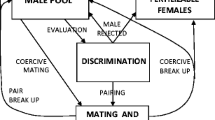Abstract.
In principle there are two approaches to modelling a trade-off between the positive and negative outcomes of a behavior: after suitably defining a value for the behavior in the absence of any trade-off, one can either multiply that value by an appropriate discount or subtract an appropriate cost. In a prospective analysis of sperm competition, Parker (Proc. Roy. Soc. Lond. B (1990) 242, 120–126) adopted the multiplicative approach to model the trade-off between the value of a mating and the cost of its acquisition. He obtained two paradoxical results. First, if two males ‘know’ whether they are first or second to mate, but these roles are assigned randomly, then sperm numbers should be the same for both males whether the ‘raffle’ for fertilization is fair or unfair. Second, if mating order is constant, then a favored male should expend less on sperm. His results are puzzling not only in terms of intuition about nature, but also in terms of his model’s consistency. In other words, they present both an external and an internal paradox.
Parker assumed the fairness of the raffle to a disfavored male to be independent of how much sperm a favored male deposits. This article both generalizes Parker’s analysis by allowing fairness to decrease with sperm expenditure by the favored male and compares Parker’s results to those obtained by the additive approach. In many respects, results are similar. Nevertheless, if the costs of mating are assumed to increase with sperm expenditure but not to depend on the role in which sperm is expended, as Parker assumed, then the additive approach is more fundamentally correct. In particular, Parker’s constant-role paradox is an artifact of his approach. His random-role paradox is internally rationalized in terms of standard microeconomic theory.
When fairness decreases, however slightly, with sperm expenditure by the favored male, both models demonstrate that the evolutionarily stable strategy is for more sperm to be deposited during a favored mating than during a disfavored mating. The lower the costs, the greater the divergence. Thus a possible resolution of the external paradox is that fairness is not constant in nature.
Similar content being viewed by others
Author information
Authors and Affiliations
Additional information
Received: 7 December 1998
Rights and permissions
About this article
Cite this article
Mesterton-Gibbons, M. On sperm competition games: raffles and roles revisited. J Math Biol 39, 91–108 (1999). https://doi.org/10.1007/s002850050164
Issue Date:
DOI: https://doi.org/10.1007/s002850050164




